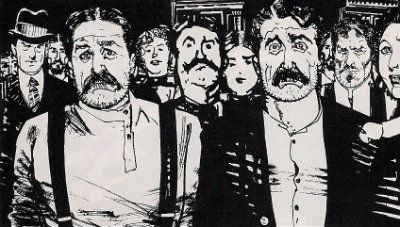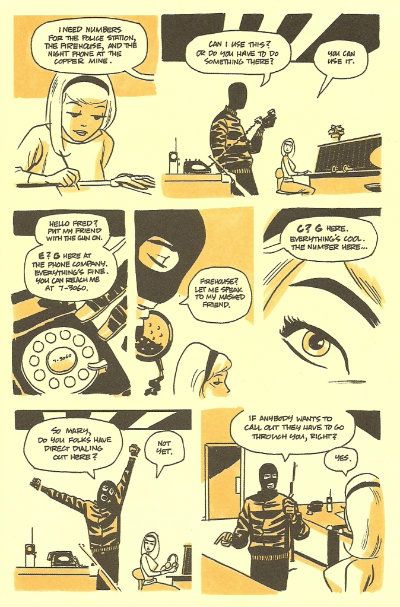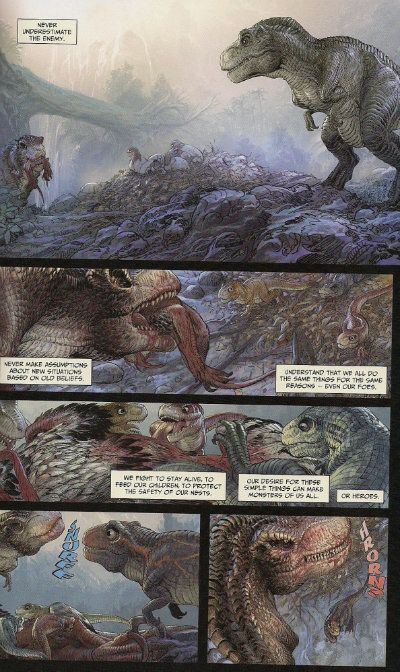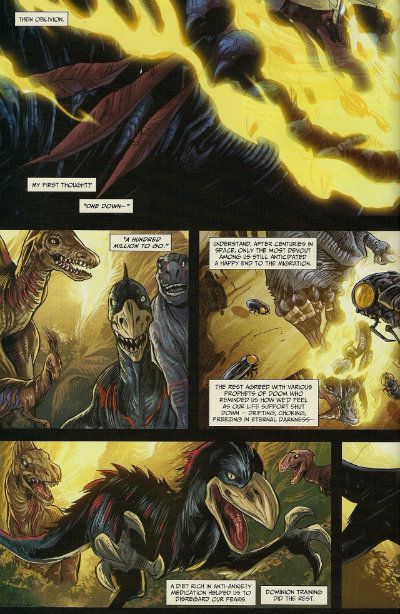Being a Jess Nevens-like modular exegesis of Episode 1 of
Comic Books Are Burning In Hell, a podcast by
Matt Seneca,
Tucker Stone,
Chris Mautner and myself.
00:00: The goddess (or d
æmoness) Smarra is the deity of choice for Oliver Haddo: W. Somerset Maugham creation, Aleister Crowley stand-in, and ultimately hapless primary antagonist of
The League of Extraordinary Gentlemen: Century, a three-issue squarebound comic book miniseries (2009-12) by Alan Moore & Kevin O'Neill, with colors by Ben Dimagmaliw and letters/design by Todd Klein. Note, however, that the character was actually introduced in the series' prelude,
The League of Extraordinary Gentlemen: Black Dossier, a 2008 original graphic novel from the same team, with additional lettering by the late Bill Oakley; given that Oakley died in 2004, we can fairly say that this project has been building toward completion for nearly a decade.
In contrast, this podcast has been building toward its debut episode for nine weeks, which is slightly less time than Zalman King gave Mickey Rourke - an early release, by our passion for you.
This is not creepy.
This is
comics.
00:08: A new launch deserves a new theme song, so once again we give you the excellent
Miss Nina Stone. I kinda liked the jazzy inflections of the first one, but I also think this new jingle (CBABIH OP2) fits the "burning in hell" theme in a manner that doesn't tacitly impugn the metaphysical standing of record collectors across the mighty history of alternative comics. I'm also a huge fan of title songs where the lyrics are the title; I'm watching the 1971
Lupin the 3rd anime right now, and they do the same awesome thing. I just hope that one day I too can be considered
a nice man.
00:40: This episode was recorded on Sunday, July 8, 2012, in all the usual places: Brooklyn, NY (Tucker & Matt) and Elizabethtown, PA (me & Chris). We did it (once again) as the first half of a block with next week's episode directly to follow, but we actually wound up going way over our self-imposed time limit. I think Tucker cut about 10-15 minutes of material out of the final release - mostly dead ends, vulgar speculations and bad jokes, which admittedly is the primary draw of this show, but you folks only got the
gold.
01:25: The final fate of
Big Numbers -- a England-set 'literary' comic by Moore, artist Bill Sienkiewicz and prominent art assistant/eventual aborted replacement artist Al Columbia, intended to run for twelve issues, though only two were published, in 1990 -- is a matter of some conjecture; Eddie Campbell provides perhaps the most memorable account in his book
How to Be an Artist (presently collected in the Top Shelf omnibus
Alec: The Years Have Pants), although interested parties are further directed to
Sienkiewicz's take, posted after
a photocopy of the unreleased issue #3 appeared online.
01:32: I am no doubt simplifying Moore's motives here; the 'official' line, as it goes, can be best experienced through George Khoury's
The Extraordinary Works of Alan Moore, which is basically a book-length interview spanning Moore's entire career through 2008 (as of the latest edition). It was actually Moore's old
The Saga of the Swamp Thing cohorts Stephen R. Bissette & Rick Veitch that established his relationship with Image through the six-issue miniseries
1963 ('93) (an added, concluding special issue was never completed), the production of which led, per Moore, to his writing
Spawn #8 (also '93), and eventually a long attempt at writing for an audience concerned with "almost no story, just lots of big, full-page pin-up sort of pieces of artwork." Some of these comics were quite good, and some of them were
Spawn/WildC.A.T.s or the notorious event miniseries
Fire from Heaven, half of which, according to Khoury, was actually written by an unknown party working under Moore's name.
01:52: The ghosts of my childhood favorites demand I specify Moore's guest-dialogued issue of
The Maxx as #21 (Jan. '96), and his Shadowhawk thing as a story in the
Shadowhawks of Legend anthology ('95). I wrote a bit about Moore's
Vampirella story
here. The internet connection is a little weird for the first 1/3 of the episode, so I sound pretty metal at times, though I don't know why I'm slurring my words so much - I wasn't nearly as drunk as I get writing these notes.
03:05: The first six-issue
The League of Extraordinary Gentlemen miniseries ran from March of 1999 through September of 2000; the second six-issue miniseries ran from September of 2002 through November of 2003; somewhat unsurprisingly, the
Century miniseries adopted what's essentially the Franco-Belgian album schedule (if not the album format), seeing new 80-page issues released at greater-than one year intervals.
04:32: Of course,
Paul Verhoeven fans know that biological warfare dates back to the dark ages, when you'd just launch a plague-ridden carcass over the walls and
boom. It just occurs to me now, though, that Nemo is the thematically unifying force concerning the first two series' take on violence - he goes from ruthless and gleeful in vol.1 to utterly disgusted and horrified by the end of vol. 2, leading to his divorce from even nominally friendly contact with England. A descendant also shows up at the end of
Century (elsewhere too, bear with me), but mostly to drop a potential
Watchmen teetering-the-world-toward-collapse-for-its-own-good reference. Supposedly the next LoEG project is
Nemo - Heart of Ice, a 48-page side-story set in the 1920s (due Feb. '13), so maybe a bit more connecting fiber will be offered.
05:01: Note, however, that the America's Best Comics line was maintained irregularly in Moore's absence, most recently via the 2010-11 Peter Hogan/Chris Sprouse miniseries
Tom Strong and the Robots of Doom. Now that Wildstorm itself has folded, we can presume it's dead, and that forthcoming
Top Ten sequels can be expected under the DC banner after the
Watchmen cast is folded into continuity in a couple of years. Yeah, you're laughing, but you don't sell half a million comic books in five weeks and expect things to just end, do you? "Nothing ever ends."
Here's Tilda Swinton.
05:49: In fact, Crowley's own stand-in creation was Cyril Grey, a bit character in the initial
1910 chapter of
Century, although the conception of a "moonchild," Haddo's aim, is central to the plot of Crowley's 1917 novel
Moonchild, in which Grey featured. Tucker helpfully edited out the part where I shout "I HATE MYSELF I HATE MYSELF" for 45 consecutive seconds.
08:11: Regrettably, that's not Chris' wife and children, that's a sound effect. Regarding Poppins, amypoodle of the Mindless Ones
suggests that she might actually
be Haddo's Smarra, or at least Smarra might be an aspect of her... omnibus divinity? Anyway, it's reductive to refer to Mary Poppins as God from the Bible, but I do try to keep up the mainline Abrahamic appearances suggested by this show's title.
08:48: Supportive of this point is Moore's 2010 minicomic
Astounding Weird Penises, a pack-in with issue #2 of
Dodgem Logic magazine (which Matt explains later) and the first longform comic in decades which Moore both wrote and drew; it's a far-out pastiche of vintage EC stuff, basically in line with a '70s second-wave underground comix rag.
13:44: Not that there's an exact correlation between the two writers' styles, but the presence of
Iain Sinclair's Norton, Prisoner of London -- from his 1997 book
Slow Chocolate Autopsy, composed in part with illustrations by Dave McKean, for a ready-made comics connection -- as a bridge between the time periods of
Century perhaps gestures toward Moore's allusive intent; Sinclair was also a midwife of sorts to Moore's
Unearthing project though his
London: City of Disappearances anthology, and of course inspired all the really fun bits of
From Hell through his 1975 work
Lud Heat (reissued by
Skylight Press just two months ago). And yes - as Matt notes later on, I did come to Sinclair through Moore, and I suspect I'm far from alone.
14:40: Naturally, this morning I got an email explaining something I'd never even considered - the
Harry Potter movies are a gigantic cash cow for Warner Brothers, of which DC Comics is a subsidiary, suggesting a certain potential for specific investment in the satire Moore is slinging. Mary Poppins, on the other hand, is popularly associated with Disney - you can see where this is going.
18:37: Dickish as this sounds given how many errors I tend to make in a given show, I do believe Ben Dimagmaliw is from the Philippines, and resides in the United States.
20:04: This implicates the notion of widespread success/recognition/influence vs. general acclaim, I think; certainly there are a lot of hugely respected and honored prose/poetry figures in the UK today, although talk of this tends to bring me back to Tucker's suggestion a few shows back that the modern League should be comprised solely of uninspiring protagonists from contemporary literary novels. The type of comics Moore is making begs a certain breed of reference, although I guess a modern genre commentary like (say) Lev Grossman's
The Magicians would suffice; but does it have the reach a man who's shrugged off millions upon millions in movie fees -- as rude and blunt a validation of mass cultural 'worth' as our times can summon -- must know he's got?
22:08: Indeed, if you take the well-bearded Allan Quatermain of
Century's end as a stand-in for Moore himself, the series' ending can be read as an acknowledgement of the writer's irrelevance as a white male in directing the present cultural discussion in a beneficial way, his legacy of colonialism and paternalistic attitudes left dead and buried under the African sky. However, this potential is intermingled with a romantic appreciation for the value of right proper old-time heroics; query whether its offenses don't appear to dim before the overwhelming, purposeless banality of the contemporary age the women have inherited. As with Moore's superhero works, there's appreciation ground in with the devastation...
24:31: To expand on this marvelously succinct and crystal-clear lecture I have just somersaulted through, the "self-contained literary mechanism" I describe is probably what best separates Moore's usage of appropriated/analogized or corporate-owned characters from the typical continued serializations of characters that have outlived their creators, so that when Moore uses IPs from all over the DCU in
The Saga of the Swamp Thing, it's to build up a literary statement on the absurdities and horrors and surprises of vastly different extra-normal entities occupying the same world. Likewise,
1963 is about the legacy of the early Marvel comics,
Supreme is about the history of Superman, and
Spawn/WildC.A.T.s is about 35 minutes you'll beg to have again while dying. I mean, it doesn't happen
every time, but the general thrust of Moore's work is different than something like
Before Watchmen, which not only acts as a simple adjunct to an earlier work, but actually paraphrases and quotes from the original extensively, so as to insinuate itself into the very fabric of the original, and thus become it.
Shit, you can even call Moore a die-hard classicist on these grounds, since he's concerned with the agency of the author, while the windows-unto-virtual-reality setup of superhero continuity, per Grant Morrison, can be taken as a distinctly applicable means of navigating-by-analogy the extra-personal media sprawl of our wired age. It's also undoubtedly the wave of the future in terms of guaranteeing audience recognition in a time of massive blockbuster films and lackluster disposable cash flow among the potential audience.
Do note that when I say feminism in 'geek culture' has acted as a signatory to corporate-dictated terms, I'm not attempting to denigrate a very necessary discussion; I'm merely describing the shape of things in a scene where discussion itself -- even in the form of outrage -- is kept rolling by the steady flow of superhero comics released every week, so that even basic discussions of representation and femininity in comics are now typically couched in terms that emphasize the inspirational value of heroic figures, vis-à-vis their empowered and de-powered states. Such discussion affirms the cultural reach of owner corporations, insofar as decades-old, company-maintained superheroes are inevitably the most recognizable. Even if the outer parameters of comic book reading in North America encompasses only half a million people, these characters are licensed, packaged and disseminated at a level of visibility that alternative images can't hope to match. In other words, superheroes 'matter,' not because comics are a thing of mass culture, but because they can, in this form, potentially expand into mass media. Alan Moore, while cognizant of of the extra-textual implications of stories and characters, no doubt sees himself in opposition to such machinations, and thus we have his problem.
This is not the only sort of conversation going on, I hasten to add, nor is concern with such levels of visibility irrelevant or unnecessary. Yet, a crucial aspect of today's superhero fandom in general seems to be the assumed validation that comes from the success of these properties in high-profile, record-breaking movies, so that the reader -- aware, of course, that his or her reading material is willingly accessed by 0.1% of the U.S. public at absolute best -- can imagine their idle activity as explosive experimentation at ground zero of tomorrow's thrills, riding shotgun in the cockpit of the giant robot that is American popular culture.
29:16: Cruelly, we are robbed of another exciting Comic Books Are Burning In Hell live reading (don't worry, we'll pick it up later), so, in two parts:

and:

There's also a part earlier where Norton mentions that the above-pictured train "runs on sloppily-defined magical principles," although his subsequent "I'm sure you two can handle it" might be taken as either a reassurance as to the magical superiority of Orlando & Mina or a crack at their own suspect makeup. Less equivocal is Haddo's later condemnation of Harry as "a tremendous disappointment" and thrice "banal," although one might suspect the book's antagonist to be a bit of a dick and Aleister Crowley to be slightly elitist with the magic thing. Circumstantial evidence, though.
30:53: Oh god, Matt reminds me here that we didn't even get into the fucking Golliwog and fucking Alan Moore's attempt to do
Django (fucking)
Unchained in the text sections. This is
a whole different issue, if again related to a Moore/O'Neill lack of due diligence in contextualizing their usage of the character. Instead, it's a facile attempt at reclamation, isolating the racist iconography inherent to the character and re-framing it in a positive manner, which is to say attempting to strip away the racist signal: he looks like that now because he's a way-cool (uh, escaped slave) from beyond the stars! And he's quite sexually virile too, but that's because sex is a good thing! The other heroes like to have sex too! (Not with the Golliwog.) Hooray!
Granted, Moore does at least try and present the character as the most unabashedly heroic force in the entire series, but the learned comics scholars among us know this to be The Ebony White Excuse. Frankly -- and this ties in with Tucker's
awesome rant starting at 34:26 -- there's a bratty quality to the character's continued presence in the series that speaks more of a privileged amusement than anything else. What would probably be necessary is what I expect is in store with the actual
Django Unchained: a construct that acknowledges the pervasive racism from which such tropes and images emerged at every turn.
31:44: This is another connection between
Black Dossier and
Century, as the former was initially promoted as including a disc of 'period' songs, actually written and performed by Moore & co.; I believe it was nixed as overly expensive. Is now the time to plug Top Shelf's upcoming reissue of Moore's
The Bojeffries Saga with Steve Parkhouse? Musical interludes in that, yes.

Y'know, Moore's own track
was one of the better things on
the Dodgem Logic mixtape... probably right behind
this, which twisted me into an fetal position from praying
so hard that Moore would drop a guest verse...
37:20: Overall I'd say the Kickstarter joke was by far the most current reference in
2009, enough so that I went scrambling to Wikipedia to affirm that the site even existed in some form three years ago (A: yes). Also:
tank-top.
54:29: Here's
Plok's take -
much more eloquent than my summary, so please read it through!
58:12: LIVE READING. Chris' interview with Moore is
online, although he's reading here from its anthologized printing in
Alan Moore: Conversations (ed. Eric L. Berlatsky). Here's a slightly longer excerpt:
"What I was trying to say in my muddled, roundabout fashion was that of
course the material that is purely in the mind, how can it be anything
other than innocent? Especially when contrasted with the stuff that
we’re seeing on our televisions every day of children being carried limp
and bloody out of rubble. These are real children in a real world.
"With 'Lost Girls' we hoped to have a sense of perspective on this. There is
nothing as terrible as war. And whatever our current moral panics might
say, even child molesting is not as terrible as war. And the imagery and
the concept of child molesting is certainly not as terrible as war.
"That
is not to say the abuse of children is not terrible. Of course it is.
The abuse of anybody is terrible. I don’t know if sexual abuse is more
terrible than any other kind or whether it’s because we seem to apply a
huge amount of power to the sexual realm. Like the whole idea of rape as
a fate worth than death.
"I remember talking to Kathy Acker, the
late, lamented Kathy Acker about that issue. I remember her saying that
she had been raped and she says 'You go home, you have a wash, you feel
kind of messed up for awhile but you’re glad that you weren’t killed.'
There is no fate worse than death."
01:01:53: Aww, there's my darlin'! That cry at the end was joy.
"
Not creepy. Comics."











